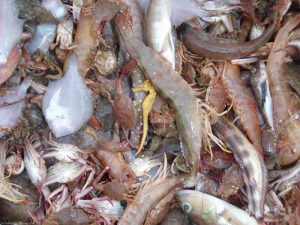What happens to the seahorses that you accidentally land in your trawl net?
By Stephen Cain, RJD Intern
For millennia our ancestors fished the world’s oceans. Today’s fishing fleets are the most effective in all of human history, extracting ever-larger quantities of wild fishes. Only recently have scientists shown that seas are vulnerable to overexploitation, which can put species at extinction risk. Meanwhile, human population growth places increased pressure on marine resources to feed billions, thus representing a significant share of global trade.
The Convention on International Trade in Endangered Species of Wild Fauna and Flora (CITES) is a multinational treaty with the mandate of monitoring and regulating species trade such that wild populations remain healthy. But do large, multi-national efforts such as CITES actually work? Writing in Aquatic Conservation: Marine and Freshwater Ecosystems, researchers Sarah Foster, Stefan Wiswedel and Amanada Vincent attempt to answer this question by analyzing CITES data and by using seahorses (Hippocampus) as a case study.
2002 was a noteworthy year for CITES. For the first time in nearly 25 years the international body added a marine fauna, seahorses, to its list of Appendix II species. According to the agreement, such species are of a conservation concern in the absence of regulation, and any of the 180 member nations trading in Appendix II species must demonstrate through monitoring that trade does not harm wild populations. Previous biologic surveys of seahorses analyzed by Foster et al. showed that extensive trade existed. The genus’ life-history characteristics, such as small home ranges, low fecundity and density gave scientists cause for concern over the long-term sustainability of global populations.
Foster and her team reviewed CITES monitoring reports for the first seven years of the Appendix II listing (2004-2011). They wanted to determine its successes and obstacles, as well as uncover key relationships between market demand, trade routes, and the sources of trade.
Surveys undertaken prior to the implementation of the CITES listing showed that millions of individuals were traded annually. Seahorses were exported primarily as dried specimens for traditional Chinese medicine (TCM), and to a lesser degree as live individuals for aquaria. Remarkably, commercial trawlers that obtained seahorses as by-catch or non-targeted species met the larger demand for TCM markets. When seahorses were specifically targeted as catch, they were taken alive and destined for the aquaria trade. The United States imported the largest number of live seahorses during the study period.
In all, Foster et al. identified 31 out of 47 species of the genus Hippocampus as important species to international trade, four of which dominated by volume (H. kelloggi, H. kuda, H. spinosissimus, and H. trimaculatus). The top four, the authors noted, are species listed as threatened by the IUCN.
While reporting gaps and inconsistencies made definitive findings challenging, Foster and her team suspect that it is unlikely that the demand for seahorses has diminished in the years following the CITES designation. Monitoring of trade emerged as one of the greatest challenges for the treaty. Some countries known to export quantities of seahorses did not report. Other countries failed to specify the unit volumes of exports, which made it difficult to form a clear picture of international trade. Taken together, however, Foster et al. interpreted the monitoring failures as an area of opportunity for CITES.
The challenge now is for international authorities to build member capacity in annual reporting. For this, the researchers suggested that automated record validation, a process aided by new technology, could add precision to the accounting of imports and exports. In addition, standardized educational materials for species identification could strengthen the accuracy of reporting, and trade surveys could give a fresh perspective on species abundance. The promptness of the reporting also needs improvement. In some instances a country’s current reporting period represented data collected two years prior.
The measures of success for a CITES listing really come from accurate longitudinal data. As long as countries around the globe participate in and strengthen monitoring practices, Foster and her team are confident it can be a useful tool in the conservation of species. But the team is cautious in the case of seahorses. CITES listings may have little bearing on species caught as by-catch. Commercial fishers who cash in on seahorses from by-catch are capitalizing on a market demand for a fishing pressure that they have already exerted, even if accidentally. The question of whether or not they can undo that pressure, either by altering gear types or by releasing non-targeted species, is a complicated one. In the end, the decision may not rest squarely on the shoulders of the international community, but on our species.
You can find this paper in Aquatic Conservation: Marine and Freshwater Ecosystems
Foster, S., Wiswedel, S., & Vincent, A. (2014). Opportunities and challenges for analysis of wildlife trade using CITES data – seahorses as a case study. Aquatic Conservation: Marine and Freshwater Ecosystems, http://doi.org/10.1002/aqc.2493
For the latest on seahorse research, conservation, and news, see Project Seahorse
http://seahorse.fisheries.ubc.ca/

